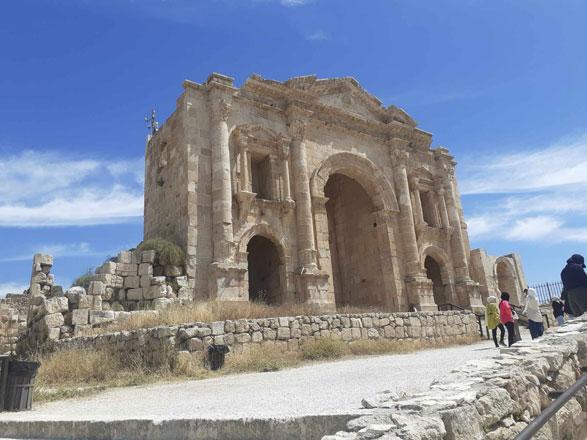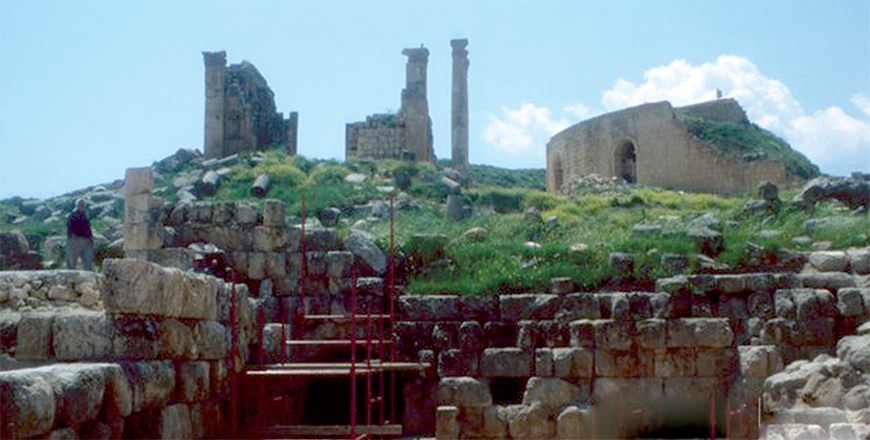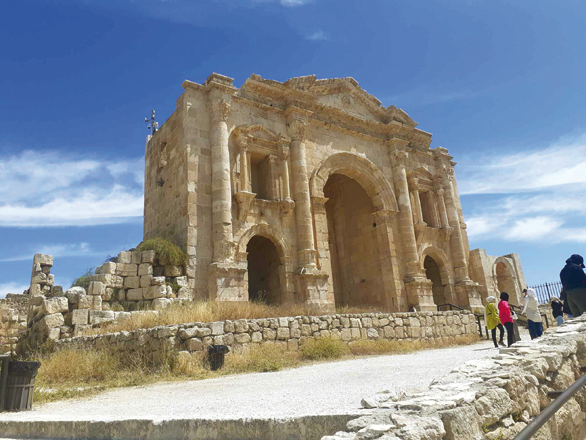You are here
Ancient prosperity: Reevaluating Jerash’s urban development
By Saeb Rawashdeh - Jul 16,2024 - Last updated at Jul 16,2024

Hadrian's Arch in Gerasa, erected to commemorate visit of Emperor Hadrian to Gerasa in 129/130AD (Photo of Saeb Rawashdeh)
AMMAN — In the 1st century BC and 1st century AD, Gerasa (modern Jerash) had operational quarries, which are types of open-pit mines used for excavating dimension stone, rock, sand or gravel from the ground. It seems that the first quarries were late Hellenistic and they were abandoned in the 2nd century AD, when Emperor Hadrian visited Gerasa in 129/130AD.
Analysing quarries helps scholars determine the urban development and the number of citizens in Gerasa.
"When trying to assess the size of the population of first century Gerasa, evidence is hard to come by: Estimated seating in the South Theatre is approximately 3000, counting the seat stones but that number is far below even a mean average," said the scholar Ina Kehrberg-Ostrasz, adding that kiln dumps (representing only a fraction of production) and the tombs still in operation could add valuable information about the growth of population as well as urban spread.
The hypothesis that Gerasa grew from one central nucleus in the south and gradually spread to the north of the city was presented on the basis that the sanctuary of Zeus was the first, and most important, Kehrberg-Ostrasz maintained, adding that from this generally adopted view derived the idea that architectural blocks of the first centuries BC and AD reused as spolia at their sites belonged to this southern cult centre, or vice versa.
However, the old theory should be reviewed. "Archaeological evidence for use of first-century spolia is evenly spread in the north and south Gerasa, where early blocks have been found in foundation sand simple wall structures of later periods," Kehrberg-Ostrasz said, adding that once one accepts the possibility that the north was also populated in the first century, there is little reason to assume that the second-century population transported spolia as a building material from the south to the north of the city.
It appears reasonable to propose instead, that the Gerasene builder quarried for ready-made blocks close at hand, Kehrberg-Ostrasz underlined.
The latter theory is reinforced by first and early second-century temples in the northern “district”. These are the Artemis Temple and Dionysus Temple.
"Pottery kilns and large-scale commerce in ceramics had been operational before and during the construction phases of urban second-century Gerasa, and the evidence comes from foundation fills of the hippodrome, whose dirt includes misfired pottery and wasters from the 1st century BC to the early century AD," Kehrberg-Ostrasz highlighted, noting that the pottery workshops in this area must have been moved when the necropolis was closed for the construction of Hadrian’s Arch followed a little later by the hippodrome.
Moreover, the 2nd-century potters may have moved from the hippodrome to set up business nearer the Zeus Sanctuary, on the periphery of what became the upper temple complex, possibly joining other workshops.
"Pottery kilns probably continued to be in operation during construction of the upper temple complex of the Zeus Sanctuary around 160AD, " said Kehrberg-Ostrasz, adding that few archaeological teams working in Jerash have been able to study their sites and excavated material in such detail and much of the "secondary" or non-architectural evidence which helps identify cycles of reuse of a site has been lost, especially for the Roman periods.
According to Kehrberg-Ostrasz, architectural remains are still regarded as the main source, whilst pottery, kiln wastes, and other litter tend to be "valued" more for their usefulness as dating tools than for their suitability as complementary studies of urban settlement.
Kehrberg-Ostrasz concluded that Gerasa’s population was prosperous and must have relied on trade in local goods, notably ceramics, for a good part of its revenues.
Related Articles
AMMAN — When the Roman Emperor Hadrian visited Gerasa (ancient Jerash) in 129/130 AD, the Roman Empire was at its peak.
AMMAN — Ancient Gerasa (modern Jerash) was a well-known centre for pottery production: The evidence for that large scale commerce comes from
AMMAN — The major renovation of Gerasa (modern Jerash) took place in the first half of the 2nd century AD when the Roman Emperor Hadrian vis














